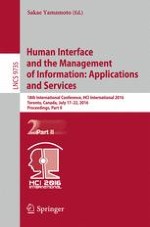2016 | OriginalPaper | Chapter
A Mechanism to Control Aggressive Comments in Pseudonym Type Computer Mediated Communications
Authors : Hiroki Yamaguchi, Tetsuya Maeshiro
Published in: Human Interface and the Management of Information: Applications and Services
Publisher: Springer International Publishing
Activate our intelligent search to find suitable subject content or patents.
Select sections of text to find matching patents with Artificial Intelligence. powered by
Select sections of text to find additional relevant content using AI-assisted search. powered by
